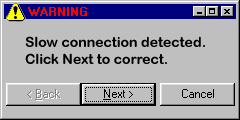How to speed up Internet connection. Download accelerators. Modem boosters. |
||
|
Modem Momentum If you're able, get cable. Among the new waves of technology washing ashore in recent years are cable modems - devices for gaining very high-speed Internet access through a cable television network.High bandwidth technologies like cable modems are important to teleworkers… if the technology isn't as fast at home as in the office, then neither is the worker. AT&T has been investing heavily in enhancing cable infrastructures, working to offer Internet, cable TV and telephone access through these networks. At the heart of this strategy lies the cable modem: Why is it needed? What is it? What does it do? How does it do it? And how do you get one? What is it? While similar in some ways to the analog modem you may currently have, a cable modem is much more powerful - theoretically, as much as up to 1,000 times faster. (Throughput, however, actually never reaches theoretical speeds outside of controlled lab conditions, just as your 56k modem never reaches its top-rated speed.) What does it do? A cable modem is still the fastest Internet service for your home. Adding to the speed boost is the "always on" Internet connection that doesn't require dialing in every time you want to go online. And you can continue to receive television over the same cable, while data services can be shared by up to sixteen PCs in a home-based LAN configuration. How does it do it? With cable modems, users served by a "node" (from 200-2000 homes, depending on the provider) share the available bandwidth. A key component is the central transmission facility, known as the "head-end". Subscribers connect to the head-end, which connects to the Internet and to satellite television transmission systems. Privacy and security, data networking, and quality control are integrated into the network at the head-ends. Upstream and down.The cable modem converts data signals into a form suitable for rapid transmission. Data moving from the cable network to you is known as "downstream" data, while "upstream" data moves from you to the network. (Because most cable networks were built for television, some cable modems use a telephone line to transmit data upstream.) Downstream data is designed to move faster, while upstream data is sent at variable speeds managed by the head-end. Data rates can be configured to meet different user needs. For example, an e-commerce business needs to send and receive at higher speeds, while a residential user is normally set up to receive at a relatively high rate and send at a slower one. After all, as a single user, most of what you're sending "up" is keystrokes and mouse-clicks, whereas what's being sent "down" to you is more substantial - text, images, streaming audio and video, and so on. The upstream data you send is placed on a fiber optic backbone, which carries traffic across your regional provider. This is the fastest part of the trip. Here, data moves at rates near the speed of light. For the rest of the journey, your data may encounter slower media - copper wire - as well as "choke points" where it has to wait its turn. On the return trip, the head-end combines the downstream data with the television video and audio and sends the composite signal to you. The signal is re-divided at your house so that the television signal goes to your TV and the Internet data goes to your PC. In almost all cases, cable modem userswill see speeds that exceed an ISDN connection. Performance: A cable data network is similar to an office local area network (LAN) on a larger scale. The local cable provider manages an extended Ethernet network over a wide geographic area. If you were the only user served by a neighborhood node on this network, you'd have all the bandwidth to yourself. When all your neighbors also have cable modems, speeds go down somewhat - just as heavy traffic slows down rush hour, a high volume of users on a node reduces data throughput (especially if they're using lots of bandwidth to view streaming media, for example). Cable providers will usually add a node to an area to ease such congestion. Some Internet content is cached (temporarily stored) at the head-end to provide users with quicker access. Of course, not all web content can be cached, and so your request may travel beyond the head-end and across the Internet. Once you're beyond the head-end, you're on the same Internet as everyone else and subject to the same delays. But in almost all cases, cable modem users will see throughput to the cable head-end and to the wider Internet at speeds that exceed those of an ISDN connection. While definitive statements about actual speed are impossible, the perceptible difference between regular and cable modems is dramatic. Web pages, especially "popular" ones, pop up instantly. Large files download in seconds. Streaming audio and video activate without perceptible delay. This all nets out (no pun intended) in leaps in productivity - more working time and less "hourglass" time. I'll Take One! By now, you may be asking, "So, where do I sign up?" You can begin by going to www.home.com, the online source for @Home cable modem services. Click the highlighted link for "Can I get @Home?" and enter your address to see if the service is available in your area. If it's not yet available in your neighborhood, @Home will contact you when it is.
|
|
| Boost internet speed - surf the web faster | Download Internet Optimizers. Boost Internet Speed. | Internet Optimizer. Accelerate Internet connection speed. | Optimize Internet Connection and Boost Speed for faster downloads. |

